Maria is simply brilliant. She is fabulous, warm and extremely caring person. We were walking in one other hottest days in Osaka. She ensured we stayed cool, easy and comfortable. Also her knowledge is awesome and she is committed yet very flexible with the agenda. Best wishes to her always..Ranadeb, Osaka, 2025
Table Of Contents
- A District That Time Glitched
- What Makes Shinsekai Special in Japan?
- Exploring Tsutenkaku Tower: Views and Hidden Gems
- Spa World: Japan's Most Eclectic Bathing Experience
- Nightlife & Neon: When Shinsekai Comes Alive
- Janjan Yokocho: A Shopping Street Frozen in Time
- From Tennoji Zoo to Osaka Castle: A Perfect Day Trip
- How Locals Experience Shinsekai Differently
- Getting There: Transit Connections and Timing
- The Enduring Allure of Shinsekai’s Surrealism
A District That Time Glitched
I was twelve when my grandmother dragged me through the neon-soaked chaos of Shinsekai Osaka. “This place,” she said, pausing under a garish pachinko sign, “is what happens when the future gets drunk and forgets to grow up.”
The Shinsekai area is located within Osaka City, occupying a peculiar corner of its geography. While the rest of this bustling city modernizes with precision, this district feels frozen in a perpetual retro atmosphere. It’s equal parts nostalgic and surreal. The northern part of Shinsekai was modeled after Paris, with inspiration drawn from the Eiffel Tower, giving the area a unique blend of Western and Japanese influences. The new world concept, originally built to embody progress, now exists as a unique place where locals and tourists converge.
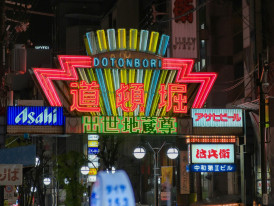
Entrance to Janjan Yokocho lit by colorful blinking neon signs at night. Image by Haoli Chen on Unsplash.
The first thing that hits visitors isn’t the sight but the sound. Arcade games, sizzling kushikatsu, and endless conversations. The shops, eateries, and attractions in the Shinsekai area attract customers with their nostalgic ambiance and unique offerings, making the district lively and inviting. Then comes the visual assault. Neon lights stacked like playing cards, each more audacious than the last.
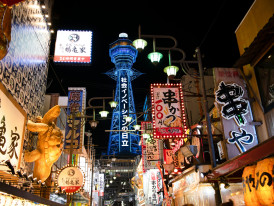
Wide view of Shinsekai’s main street with stacked signs, shops, and people walking under bright storefront lights. Image by David Dibert on Pexels.
What Makes Shinsekai Special in Japan?
The New World That Never Grew Up
The name translates to "new world," which feels like cosmic irony. When planners conceived Shinsekai Osaka in the early 1900s, they imagined a district embodying international sophistication. The original Tsutenkaku tower, modeled after the Eiffel Tower, was supposed to be the crown jewel.
That original tower, completed in 1912, was dismantled in 1943 following fire damage during World War II. What emerged was something unplanned. A neighborhood built around eccentricity. Modern Shinsekai stretches from Dobutsuen Mae station to the current tower. It's a compact area you can walk in twenty minutes, though that defeats the point.
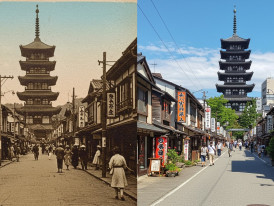
Side-by-side display of vintage and modern postcards highlighting how Shinsekai has evolved over time
The district refuses to apologize for what it is. A working-class town that happens to be photogenic, serving locals first while accommodating tourists.
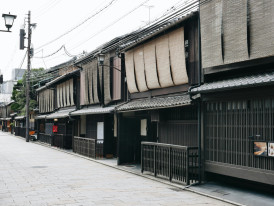
Close-up of pre-war Shinsekai architecture with ornate building facades and vintage structural details. Image by Falco Negenman on Unsplash.
Where to Find the Best Kushikatsu Restaurants?
Kushikatsu isn't just delicious street food in Shinsekai. It's religion. The cardinal rule: no double-dipping in communal sauce. Break this law, and locals will remember.
- Kushikatsu Daruma remains the most famous institution. Their main store, recognizable by the giant blowfish lantern, serves perfectly balanced deep-fried skewers. The sauce carries decades of accumulated flavors.
- Yokozuna Tsutenkaku Branch takes a different approach. Their kushikatsu tends toward experimental. I've had versions with quail egg and mochi that shouldn't work but absolutely do.
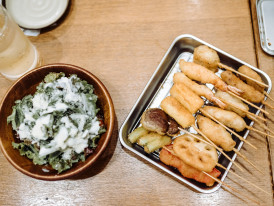
Golden, crispy kushikatsu skewers just fried and served on a metal tray, ready to eat.
For local specialties, seek out smaller eateries tucked away on side streets. These kushikatsu restaurants cater to neighborhood regulars, focusing on consistency over spectacle.
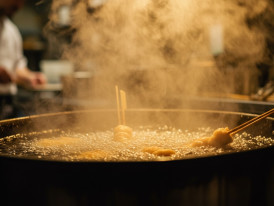
Hot oil steams as a chef prepares kushikatsu in the background of a busy Shinsekai kitchen.
Exploring Tsutenkaku Tower: Views and Hidden Gems
The Tower That Defines Shinsekai
The Tsutenkaku Tower stands 103 meters tall. It's modest by modern standards but perfectly proportioned for this district. The observation deck sits at about 91 meters and offers wide panoramic views of Osaka City. Though not necessarily Osaka Bay.
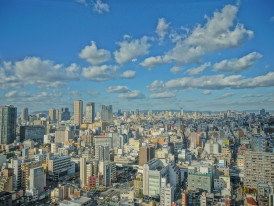
Panoramic cityscape of Osaka as seen from Tsutenkaku’s observation deck on a clear day. Image by Dong Chan Kim from Pixabay.
What makes the tower experience distinctive is perspective. From the observation deck, Shinsekai's chaos reveals underlying logic. The narrow streets form intricate patterns, while neon lights create a luminous mosaic.
The tower houses exhibits ranging from historical displays to tributes to local mascots. The fifth floor connects to underground shops where you can buy tower-themed souvenirs. A 60-meter tower slider was added in 2022 for adventurous visitors.
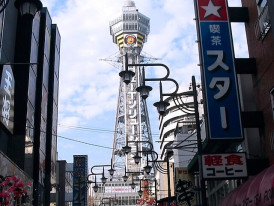
Street-level view of Tsutenkaku Tower showing its distinctive steel structure against the urban backdrop. Image by Stephen Harlan on Creative Commons Attribution 2.0
Unlike Tokyo tower or other iconic landmarks, tsutenkaku doesn't try to impress through height alone. It's a neighborhood landmark built for locals, staffed by people genuinely pleased to see visitors.
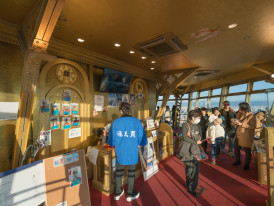
Modern exhibit space with lighting and displays inside Tsutenkaku Tower. Image by Tooykrub on Shutterstock.
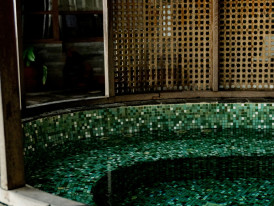
Indoor Roman-themed bath with columns and warm lighting at Spa World, Osaka. Image by Frederick Shaw on Unsplash.
Japanese-style baths on upper floors offer traditional experiences, though windows overlooking Shinsekai remind you this isn't a mountain retreat. The outdoor section provides the surreal experience of soaking while watching neon lights blink.
Spa World attracts a diverse crowd. Salarymen decompressing, tourists seeking authentic Japan experiences, and locals maintaining regular routines. This mix creates a cosmopolitan yet intimate atmosphere.
Restaurant floors serve decent food from Japanese comfort dishes to international options reflecting the spa's global theme.
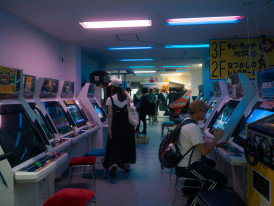
Rows of brightly lit arcade machines inside a Shinsekai gaming center. Image by Gaku Suyama on Unsplash.
Small bars tucked between shops offer intimate spaces where strangers become temporary friends over sake. Bartenders speak enough English for orders but conduct most conversations in Japanese, adding authenticity.
Karaoke lounges lean toward enthusiastic rather than polished. Song selections skew toward classics. Both Japanese and international hits from decades past.
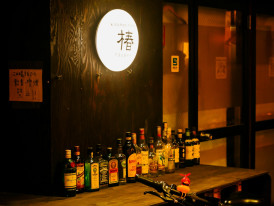
Dimly lit bar in Shinsekai with warm lighting and a few seats, creating an intimate atmosphere. Image by 5010 on Unsplash.
Street food vendors extend hours, offering late-night options perfect with alcohol. Takoyaki stands serve octopus balls steaming in cool air.
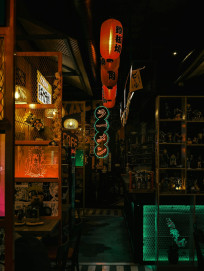
Karaoke booth featuring vintage decor, dim lighting, and a cozy retro atmosphere. Image by Nathan J Hilton on Pexels.
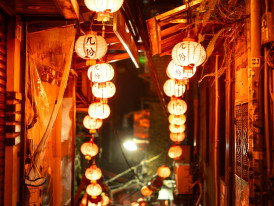
Narrow alley in Janjan Yokocho lit by hanging paper lanterns, creating a warm and nostalgic evening scene. Image by Marek Piwnicki on Unsplash.
Dobutsuen Mae Station serves as the southern anchor, while Ebisucho Station provides northern access. The walk between reveals residential streets where laundry hangs from balconies and corner shops serve regular customers.
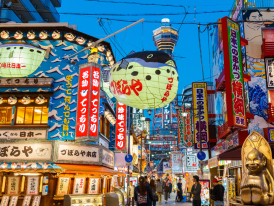
Retro items displayed in a shop window along Janjan Yokocho’s narrow shopping street.
Around Ebisucho station feels particularly local, with shops selling practical items rather than souvenirs. Here you'll find restaurants catering to regulars and quiet moments, making the neighborhood feel lived-in.
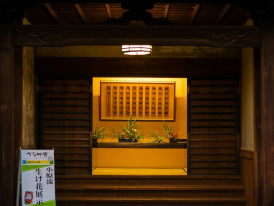
Local shrine entrance between residential buildings Photo by Kouji Tsuru on Unsplash
These quieter sections provide context for famous attractions, reminding visitors that this district functions as a real community with grocery stores and dry cleaners alongside neon and kushikatsu.
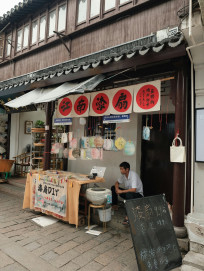
Street-level view of a traditional shop in Osaka, welcoming neighborhood customers with a simple, lived-in charm. Image by Dominic Kurniawan Suryaputra on Unsplash.
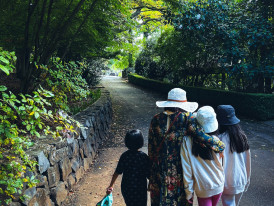
A family walks toward the main gate of Tennoji Zoo on a clear day, surrounded by trees and signage. Image by Juan Lizardo on Unsplash.
Tennoji Park extends beyond the zoo, offering open spaces providing relief from dense energy. Paths curve around ponds through preserved forest sections, feeling surprisingly remote despite the urban location.
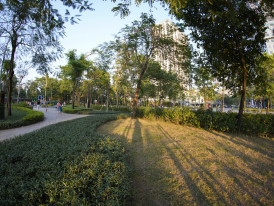
Wide green space in Tennoji Park with a clear view of Osaka’s city skyline in the distance. Image by Ngân Nguyễn Văn on Unsplash.
Osaka Castle, though requiring a short walk to Osaka Station or a JR Loop Line connection, creates an interesting historical progression. From Shinsekai's post-war reconstruction through Tennoji's green spaces to centuries-old castle foundations. Each location offers different perspectives on how Osaka evolved.
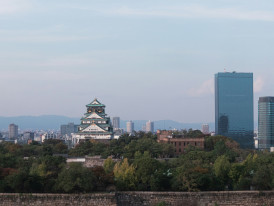
Osaka Castle seen from afar, framed by trees and buildings in the Tennoji area. Image by Tuan P. on Unsplash.
A well-planned half-day might start with morning Tennoji Zoo and Park exploration, transition through Shinsekai for lunch, then conclude with sunset views from the tower. This progression moves from natural to urban to elevated perspectives.
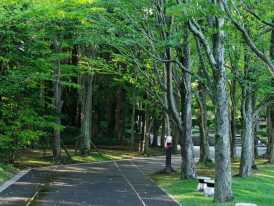
Peaceful path shaded by trees in Tennoji Park, ideal for strolling or relaxing in nature. Image by Naoki Suzuki on Unsplash.
The proximity reflects something essential about Osaka. The city's ability to contain multitudes without losing coherence. From designed wilderness to designed chaos, each space serves different functions while contributing to the larger ecosystem.
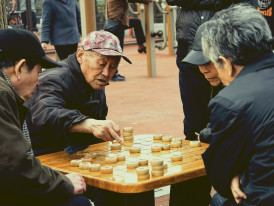
Local man focused on a game of shogi at a small table outside a kushikatsu shop in Shinsekai. Image by Woody Yan on Unsplash.
Regular customers enjoy privileges from familiarity. Preferred seating, off-menu items, and conversations developing between people who see each other regularly. These relationships create a social infrastructure that visitors observe but rarely access.
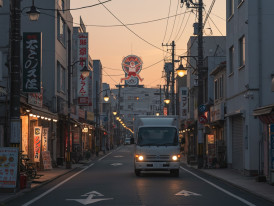
A delivery truck parked on a calm street in Shinsekai, Osaka, during early morning hours with no crowds.
The tourist version tends toward photogenic and digestible experiences. This isn't negative. The district's visual appeal and food culture deserve appreciation. But it represents a curated reality. Most visitors experience the greatest hits without encountering quieter moments.
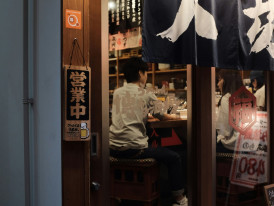
A regular customer shares a friendly conversation with the restaurant owner inside a cozy Shinsekai eatery. Images by Mak on Unsplash.
Gentrification affects Shinsekai differently from other historic districts. Working-class identity and rough reputation provide some protection against rapid upscaling, but rising property values create ongoing tensions.

Modest multi-story residential building reflecting the everyday architecture of Shinsekai neighborhood in Osaka. Image by Luca Deasti on Unsplash.
The challenge facing Shinsekai is maintaining authentic character while accommodating legitimate visitor interest. The appeal lies partly in the refusal to be sanitized or overly managed.
Getting There: Transit Connections and Timing
Best Ways to Visit Osaka's New World
Shinsekai enjoys excellent transit connections reflecting its central location. The JR Loop Line stops at Shin Imamiya Station, providing convenient access to the main areas. From Shin Imamiya Station, it's a short walk to the tower and kushikatsu district.
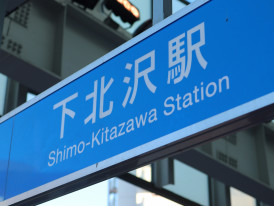
Station signs directing passengers toward Shinsekai attractions, including Tsutenkaku Tower and local shopping streets. Image by Oh Taeyeon on Unsplash.
Timing your visit affects the experience significantly. Afternoons between 2-5 PM offer the best lighting when natural daylight highlights architectural details, while neon lights begin competing for attention.
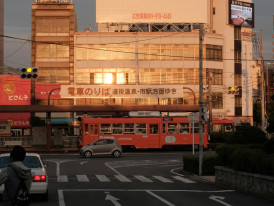
Street signs in Shinsekai glowing under golden hour light, casting a warm hue over the retro-style neighborhood scene. Image by Mak on Unsplash.
Weekday visits tend toward less crowded and more authentic experiences, with better opportunities to observe local rhythms and engage shop owners. Weekend crowds bring energy but can obscure subtler qualities.
Evening visits after 7 PM showcase a neon spectacle while avoiding dinner rush at popular restaurants. Late evening offers dramatic lighting but limits food options as establishments close early.
If you visit Osaka and want to explore beyond typical tourist attractions, Shinsekai provides authentic Japanese experiences. The district offers countless things to do that don't appear in standard guidebooks but create lasting memories.
Shinsekai's Unique Evolution in the Showa Era
Originally conceived as Japan's answer to Coney Island, Shinsekai was supposed to be an amusement park district attracting customers with international flair. The Showa era brought different realities. Post-war reconstruction built something unplanned but ultimately more interesting.

Shinsekai street at dusk with glowing signs and a soft, warm light marking the end of the day.
Today's Shinsekai embodies Osaka's essential character. It's practical but playful, traditional but adaptive, welcoming without trying too hard to please. It's a unique place rewarding attention while remaining comfortable being ignored.

Elderly local walking a well-trodden path through Shinsekai, capturing a quiet, everyday moment in the neighborhood.
Food remains central to the experience, but it's more than kushikatsu. It's social rituals of shared meals, the democracy of communal sauce bowls, and how good food creates temporary communities among strangers.

Warm sunset light reflects off rain-soaked pavement in Shinsekai, creating a moody and atmospheric street scene. Image by Mak on Unsplash.
The district provides continuity in a city that changes constantly. Not because it's frozen in time, but because it learned to evolve while maintaining essential identity. That balance between preservation and adaptation, local needs and visitor interest, and spectacle and authenticity represents something worth celebrating and protecting in Naniwa Ward and throughout Japan.
More than 26,268 5-star reviews and counting
26,268+ 5-Star Reviews and Counting
Trusted and recommended by travelers worldwide.
The Enduring Allure of Shinsekai’s Surrealism
Shinsekai is where Osaka’s past and present collide in a riot of neon lights, deep-fried aromas, and the hum of amusement arcades. This district is anchored by the iconic Tsutenkaku Tower, Osaka’s own answer to the Eiffel Tower. It invites visitors to step into a world that feels both nostalgic and defiantly alive. From the observation deck on the fifth floor, you’re treated to stunning panoramic views of the city, a reminder that this “new world” is still at the heart of Osaka’s story.
Wander a short walk from Shin Imamiya Station or Dobutsuen Mae Station, and you’ll find yourself in the thick of it. The retro atmosphere of Janjan Yokocho shopping street, where hidden gems and vintage shops line narrow alleys, sets the tone. Locals chat over steaming plates of kushikatsu. The district’s legendary kushikatsu restaurants, like Kushikatsu Daruma and Yokozuna Tsutenkaku Branch, serve up Osaka’s most delicious street food. Each skewer is a crispy tribute to the city’s culinary creativity.
More Than Food: The Rhythm of Shinsekai
But Shinsekai is more than just food. Spa World offers a surreal escape, with themed baths that transport you from Europe to Asia without ever leaving the building. For families, Tennoji Zoo and Tennoji Park are just a short stroll away, offering green spaces and animal encounters in the middle of the bustling city. And if you’re craving more iconic landmarks, Osaka Castle and the world-class Osaka Aquarium are easily reached via the JR Loop Line or Sakaisuji Subway Line.
What sets Shinsekai apart isn’t just its attractions. It’s the way the district pulses with life, day and night. Amusement arcades buzz with energy. Neon signs flicker against the dusk. Every corner offers a new surprise. Whether you’re a first-time tourist or a seasoned local, Shinsekai’s blend of old-school charm and modern eccentricity is impossible to resist.
These experiences represent some of the best Osaka experiences available to visitors approaching the city with curiosity. Shinsekai offers countless things to do in Osaka, creating memories that deepen rather than fade.
So if you’re planning to visit Osaka, don’t just tick off the usual sights. Let yourself get lost in Shinsekai’s surreal streets, sample its legendary street food, and soak in the views from the Tsutenkaku Tower. This is a district that refuses to be ordinary. It’s a place where the city’s heart beats loudest, and where every visit feels like stepping into a dream you won’t soon forget.
Plan your Osaka day with a local
SEE OSAKA EXPERIENCESDiscover Shinsekai: Osaka’s Retro Rebel District
Get lost in neon lights, street eats, and surreal charm with a local who knows where the good stuff’s hiding.

